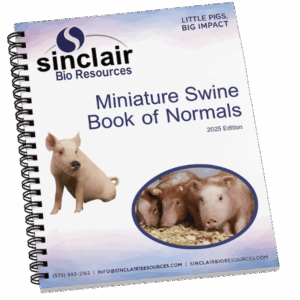
Background
-
- First miniature swine stock developed specifically for research purposes
- Developed by Hormel Institute at the University of Minnesota in 1949 by crossing four feral breeds; a Yorkshire boar later provided white hair color to the dark pigment animals
- A portion of the original Sinclair herd was acquired with breeding rights by the University of Missouri, Columbia in 1965; a few additions of Sinclair miniature swine were made from satellite herds in the early 1970s
- The colony was closed, named Sinclair S-1 miniature swine, and has been maintained since 1991 by least-related breeding program
- Sinclair Bio Resources acquired complete production and research facilities from the University of Missouri, Columbia in 1994
- The colony is fully-pedigreed
Characteristics
-
- Slow growth rate
- Smallest of the produced breeds
- A variety of hair coat colors, including white
- One lineage develops a malignant spontaneously regressing melanoma
- Used as animal models in multiple research areas including but not limited to cardiovascular, musculoskeletal, urogenital, oncology (melanoma), immunology, reproduction toxicology, teratology, dermatology, gastroenterology, respiration, nutrition, and pediatrics

